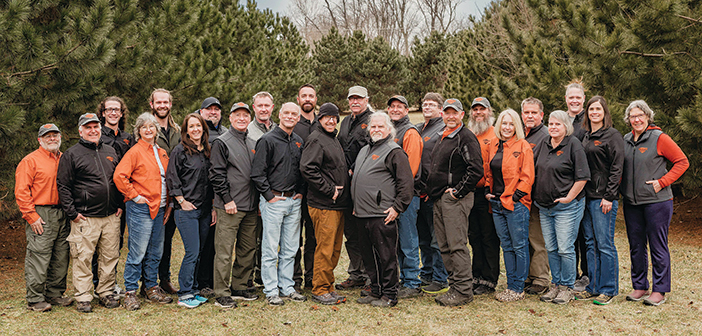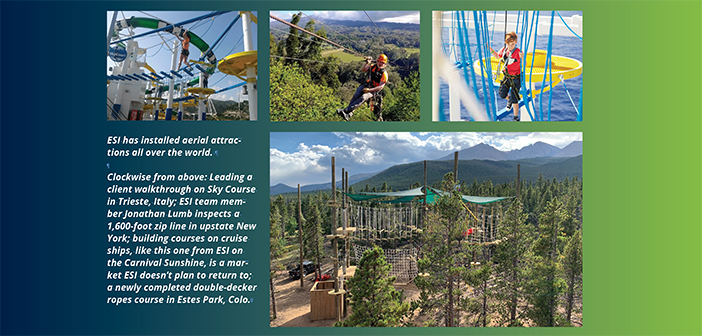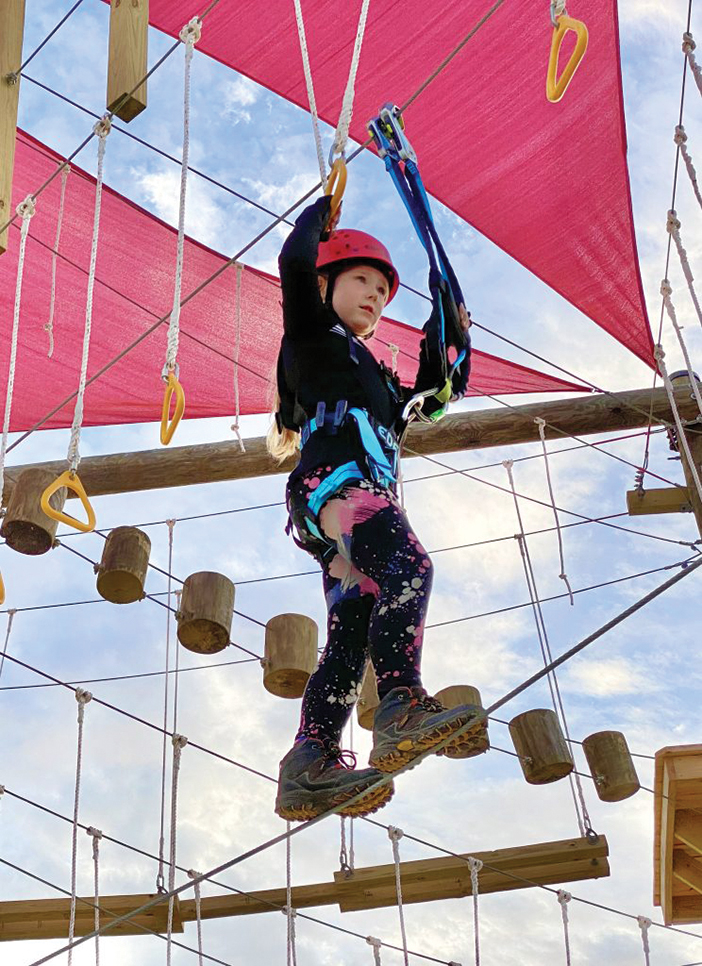You never know when a simple conversation might change the course of your life. For Keith Jacobs, owner of Experiential Systems Inc. (ESI), that conversation happened during an early-’90s climbing trip, where he struck up a chat with someone getting his master’s degree in adventure education. “I didn’t even know there was a school program for that,” says Jacobs.
At the time, Jacobs was finishing his undergraduate degree. His future yet-undecided, he went to tour the adventure program at Western Illinois University. “Three months later, I was starting my master’s with a dual major in therapeutic recreation and outdoor adventure education,” he recalls.
When Jacobs graduated in 1995, he took an assistantship at the Adventure Center at Pretty Lake in Kalamazoo, Mich., one of the oldest adventure programs in the nation, which focuses on team building, leadership, and growth. There, he met Richard Burns, an Adventure Center alum and then-owner of Experiential Systems. Burns had started the company as a side project in the ’80s, taking it full time in 1994.
Jacobs worked for Burns for several years, and also managed the now-defunct challenge course builder Cliffs and Cables. In 2002, Jacobs says, “Richard said to me, ‘you know, I’m getting kind of old to climb up and down these utility poles.’ Shortly after that, I bought Experiential Systems.”
Today, ESI is a full-service challenge course construction company. It designs and installs challenge and ropes courses, aerial adventure parks, zip lines, and climbing towers, and provides training, inspection, and repairs. It operates with 48 employees and a nine-person board of directors, which steers the ship as a team.

ESI employs 48 designers, builders, inspectors ,and trainers.
The board meets weekly to make decisions about the company, and each person is responsible for a different department. Sub teams—construction, training, inspection, etc.—work on their own objectives.
“This model of how we make decisions has been key to growth and efficiency,” Jacobs says.
The goal is “to do good work with people we love and enjoy spending time with,” he adds. “And that’s not just the staff. That’s the clients. We want to like what we do. We want to like the people that we’re doing it with, and we want to do good work that provides fun, challenging environments that are accessible to all.”
ESI has witnessed “tremendous growth” in recent years, and, like many building companies, is experiencing a post-Covid growth spurt. “2020 had a downturn, but 2021 and 2022 are the best years yet,” Jacobs says.


Traversing obstacles at the ESI-built Iron Pony Adventure Park, Va.
The journey has been a colorful one, as our conversation late this summer shows.
API: What were some of your notable early builds?
KJ: In the early days, we did a lot with school programs. In Illinois and Wisconsin, the schools have adventure education written into their curriculum. Just about every high school in Wisconsin and northwestern Illinois, at least, has a ropes course, so there was a lot of iron work in those early days.
API: So, when did you start building pay-to-play facilities?
KJ: Pay-to-play’s been around a long time. YMCAs would have Wednesday night open gym and something on Tuesday nights—they would work some of those things in. That’s been going on since the early 2000s, where people were paying and we were even doing commercial climbing-wall projects. But commercial ropes courses—canopy tours and adventure parks that were outside and not a camp or YMCA, where the client was just looking to add something else to their property—probably not until 2012 or so.
API: Were commercial zip lines around earlier than that?
KJ: We had some clients with commercial zip lines, but they were “quasi-commercial.” They were the summer camps that were, depending on what state you’re in, crossing the line into “amusement” because of how they build.
The first time we did a zip line tour, where there was more than one zip line in succession, was about 2011. We had lots of (summer camp) clients that had five or six parallel zip lines, but they weren’t considered “amusements” at that time. It wasn’t until we started doing them in succession, like a tour, that we started thinking of them as rides.
API: How did thinking about them as “rides” change the business?
KJ: It changed things a lot. That was the onset of, even before there was an ASTM standard, sending staff members to NAARSO (the National Association of Amusement Ride Safety Officers). We really started looking at the regulatory component of what we did. At the time, this was outside of ACCT (the Association for Challenge Course Technology) or the Climbing Wall Association, it was happening in the amusement world.
We started hanging out with those people and getting involved in standard-setting, as well as helping to draft legislation. That was really kind of the onset of moving to structural engineering, to where everything we build today—with the exception of maybe some low ropes courses—is fully engineered.
API: Talk about your early involvement in standards development.
KJ: We got involved pretty early with ASTM, in the early days of the ASTM F24 subcommittee F2959. My attitude early on was, “It’s a lot easier to understand and to help craft a standard than it is to fight it.”
I was the first chair of the ACCT inspector certification committee, and was saying, “Hey guys, this thing’s coming. It might only be four states right now, but you’re going to need to be certified in order to do inspections as soon as these other states decide to call you an amusement ride.” You can go through this process and learn how to inspect bounce houses and roller coasters, or we can develop our own process that focuses just on the things we do, and doesn’t involve the complex brakes, the pneumatics and hydraulics and electronics that are part of the amusement ride world.
API: How different was building before the ASTM and ACCT standards development processes?
KJ: There was a lot of what we would call “field design.” You would go out to the woods with poles or trees and cable and bolts and you would take a sketch pad and go, “All right, these are the elements I’m going to build.” And then you would build it with whatever materials were in your truck.
Back then, somebody would say, “Hey, can you build a ropes course?” And we could be out there three, four days later building a ropes course. There was certainly a lot of midnight plumbing in the early days of the industry.
API: And today?
KJ: Today, the process is about six months at minimum, at least for our company, from the time somebody signs a contract to the time we can break ground. It’s 45 days minimum to get through engineering. And then 30 to 60 days to get through permitting, depending on the municipality. And you don’t want to buy certain things until you know that your design has been approved at the permitting phase, so that sometimes throws another 30 to 45 days into the mix.
API: What’s the difference between designing traditional educational programs vs. commercial operations? Does it take a different mindset?
KJ: Absolutely. The nonprofit client has a board of directors; sometimes you’re dealing with an executive director that can make decisions, or a school board. Camps might be in an unincorporated, backwoods part of the county, where from a permitting standpoint, the county may not care.
We have a long relationship with the majority of our traditional clients—intimate, friendly relationships for 20-plus years in some cases.
With commercial clients, it’s one person or a group of investors, and there’s land issues, and permitting that doesn’t exist for some of these other entities. A school or college is often its own government entity for permitting.
And the commercial operator wants to be right off the highway. They want signage and visibility. They want to be taller and faster. These things involve a lot of meetings and a lot of planning.
If someone were to call me today and say, “I’ve got $600,000 and I want to do an adventure park,” I’m doing a bit of a background research on that person. Does this person really have money? Have they defaulted on anything? You’ve got to determine whether or not this is somebody you want a one-year or five-year relationship with. We’ve decided over the years that it’s OK to not take just any business that comes our way. Date people for a little bit. If they’re a jerk early on, they’re going be a jerk later.
API: Are there any types of projects you don’t ever want to do again?
KJ: Cruise ships. I’m not a big fan of building another ropes course on a structure that moves and isn’t in the same place every time you want to go visit it.
The cruise people are nice. Building it is nice, because you can take months building in dry dock. But it’s also subject to a lot of salt water and corrosion. And it moves. When you need to do maintenance on a project that moves—well, you have to get on the ship at eight in the morning and be off at three, or you’re traveling with the ship to the next port. You might be scheduled to work, and it’s raining and it’s outside and it moves. The people doing that work said they would be happy if we don’t sell any more of these. So we don’t.
API: How do you envision the future of the aerial adventure industry?
KJ: There’s still a lot of growth. Coming out of Covid, everybody wants more places to play outside. Trampoline parks and video arcades and places that held kids’ birthday parties were shut down for a year and a half. And all these organizations realized, “We need more things outside.” Whether it’s an aerial adventure park or an educational ropes course or a climbing tower, there’s still an abundant desire for these activities at places that don’t have them.
We’re booked through August next year. Most of the competitors I talk to are in similar boats—they’re booked out farther than they’ve ever been.
API: Did Covid help the traditional side of the industry experience a bit of a revival?
KJ: I think so. A lot of the projects we’re on right now are quasi-educational. They’ve got more grant money. Some of these programs for Salvation Army or High Peaks—they got funding in order to build more outdoor spaces. It doesn’t matter whether you’re commercial or recreational, they don’t want to put 50 kids into a cabin for crafts. They need other things for them to do outside.
API: Universal access has been a hot topic over the last couple of years. How have you stepped into that?
KJ: We’ve always employed a fair number of staff with passions around this. Carla Hacker and Melanie Wills (both well-known advocates of universal access in the aerial world) have been training for us for years. We hired Melanie to be our COO, and, really, her only task outside of company operations is growing the accessibility department. We also market toward it today.
We now have entire courses that are built to be accessible, instead of 20 or 40 percent of a course. I would say 90 percent of everything we build now has some level of an ADA arm and a four-to-one kit [for raising and lowering guests with disabilities], and a day of training associated with it. At the end of the day, it is part of our mission and vision to create structures that are usable by everybody.
API: What are your thoughts on consolidation?
KJ: I think there’s going to continue to be more consolidation in the industry. The folks that were young in 2000 are now 50, 70, and they’re tired and looking to retire. And they may not necessarily have a young guy or gal who can take over. What I hear from people when they make that shift is, “It’s just not fun anymore. I used to be able to go out in the woods and build stuff, and now it’s a lot of paperwork and compliance, and I’m not into that.”
API: What do you see as some of the challenges with inspections, currently?
KJ: One challenge is that we’ve lost a few vendors in the marketplace in the last four years, and you’ve got phones ringing more at all the vendors that are still in business to do inspections.
Most of the issues around standards are about zip lines, and there are not enough qualified tools to test and verify some of the things that the standards writers would like us to. For example, the current ACCT standard requires a backup brake for arrivals faster than six miles an hour—radar guns don’t register speeds that low.
So, there is a group of individuals writing standards that are difficult for the manufacturer and the inspector to quantify, because the tools aren’t there. As soon as you require a verification, and there are no tools to verify that, it becomes extremely difficult.
API: Parting thoughts?
KJ: One of the questions people ask me is, “What was the best thing you ever did in your business?” It was to hire somebody else to answer the phone.






